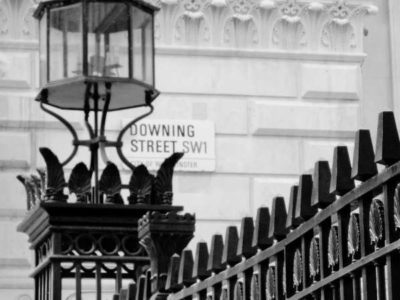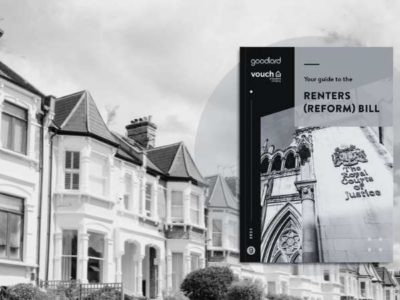The annual percentage change for average UK house prices was 9.8% in the 12 months to December 2022, compared with 10.6% in the 12 months to November 2022 and 12.0% in the 12 months to October 2022.
The average UK house price was £294,000 in December 2022, which is £26,000 higher than 12 months ago.
Average house prices increased over the year to £315,000 (10.3%) in England, to £222,000 in Wales (10.3%), to £187,000 in Scotland (5.7%) and to £175,000 in Northern Ireland (10.2%).
On a non-seasonally adjusted basis, average UK house prices decreased by 0.4% between November and December 2022, while average UK house prices increased by 0.3% during the same period 12 months ago.
House price annual growth was strongest in the East Midlands where prices increased by 12.3% in the 12 months to December 2022.
The lowest annual growth was in Scotland, where prices increased by 5.7% in the 12 months to December 2022.
London was the English region with the lowest annual growth, where prices increased by 6.7% in the 12 months to December 2022.
The Royal Institution of Chartered Surveyors’ (RICS’) December 2022 UK Residential Market Survey reported a further weakening in sales market activity to end the year.
Metrics tracking sales, instructions and price trends all slipped deeper into negative territory over the month.
Moreover, forward-looking indicators suggest housing market activity will remain on a downward trajectory over the coming months.
The Bank of England’s Agents summary of business conditions 2022 Q4 reported the supply of homes for sale increased faster than demand with higher borrowing costs and concerns about affordability weighing significantly on demand from first-time buyers.
The UK Property Transactions Statistics showed that in December 2022, on a seasonally adjusted basis, the estimated number of transactions of residential properties with a value of £40,000 or greater was 101,920.
This is 1.4% higher than 12 months ago (December 2021).
Between November and December 2022, UK transactions decreased by 2.6% on a seasonally adjusted basis.
The Bank of England’s Money and Credit December 2022 release reported that mortgage approvals for house purchases, an indicator of future borrowing, decreased to 35,600 in December 2022, from 46,200 in November 2022.
This was the fourth consecutive monthly decrease in approvals for house purchases, and the lowest since May 2020.
If the onset of the Covid-19 pandemic and period immediately thereafter is excluded, house purchase approvals are at the lowest level since January 2009 (32,400).
England
In England, the December data shows that, on average, house prices have fallen 0.2% since November 2022. The annual price rise of 10.3% takes the average property value to £315,119.
The regional data for England indicates that:
- the East Midlands experienced the greatest annual price rise, up by 12.3%
- Yorkshire and the Humber experienced the greatest monthly growth, with an increase of 0.6%
- London saw the lowest annual price growth, with an increase of 6.7%
- The South West saw the most significant monthly price fall, with a movement of –1.8%
Price change by region for England
| Region | Average price December 2022 | Annual change % since December 2021 | Monthly change % since November 2022 |
|---|---|---|---|
| East Midlands | £256,159 | 12.3 | 0.5 |
| East of England | £363,779 | 9.9 | -0.8 |
| London | £543,099 | 6.7 | 0.0 |
| North East | £163,731 | 11.7 | -0.5 |
| North West | £221,101 | 12.2 | -0.1 |
| South East | £404,229 | 10.1 | 0.4 |
| South West | £330,601 | 8.9 | -1.8 |
| West Midlands | £256,206 | 10.7 | 0.0 |
| Yorkshire and the Humber | £214,773 | 11.8 | 0.6 |
Repossession sales by volume for England
The lowest number of repossession sales in October 2022 was in the East of England.
The highest number of repossession sales in October 2022 was in the North West.
| Repossession sales | October 2022 |
|---|---|
| East Midlands | 7 |
| East of England | 2 |
| London | 7 |
| North East | 10 |
| North West | 17 |
| South East | 5 |
| South West | 5 |
| West Midlands | 3 |
| Yorkshire and the Humber | 12 |
| England | 72 |
Average price by property type for England
| Property type | December 2022 | December 2021 | Difference % |
|---|---|---|---|
| Detached | £494,459 | £446,839 | 10.7 |
| Semi-detached | £303,135 | £271,790 | 11.5 |
| Terraced | £257,846 | £234,369 | 10 |
| Flat/maisonette | £257,260 | £238,748 | 7.8 |
| All | £315,119 | £285,784 | 10.3 |
Funding and buyer status for England
| Transaction type | Average price December 2022 | Annual price change % since December 2021 | Monthly price change % since November 2022 |
|---|---|---|---|
| Cash | £294,010 | 9.2 | -0.4 |
| Mortgage | £325,544 | 10.7 | -0.1 |
| First-time buyer | £262,527 | 10.6 | 0.0 |
| Former owner occupier | £360,439 | 10 | -0.4 |
Building status for England
| Building status | Average price October 2022 | Annual price change % since October 2021 | Monthly price change % since September 2022 |
|---|---|---|---|
| New build | £425,047 | 21.1 | 1.4 |
| Existing resold property | £307,651 | 12.1 | 0.2 |
London
London shows, on average, house prices didn’t change between October 2022 and November 2022.
An annual price rise of 6.7% takes the average property value to £543,099.
Average price by property type for London
| Property type | December 2022 | December 2021 | Difference % |
|---|---|---|---|
| Detached | £1,112,825 | £1,037,453 | 7.3 |
| Semi-detached | £708,503 | £656,557 | 7.9 |
| Terraced | £593,676 | £556,229 | 6.7 |
| Flat/maisonette | £449,782 | £424,499 | 6 |
| All | £543,099 | £509,111 | 6.7 |
Funding and buyer status for London
| Transaction type | Average price December 2022 | Annual price change % since December 2021 | Monthly price change % since November 2022 |
|---|---|---|---|
| Cash | £558,237 | 5.7 | 0.2 |
| Mortgage | £537,446 | 6.9 | 0.0 |
| First-time buyer | £469,496 | 7 | 0.2 |
| Former owner occupier | £623,114 | 6.3 | -0.2 |
Building status for London
| Building status | Average price October 2022 | Annual price change % since October 2021 | Monthly price change % since September 2022 |
|---|---|---|---|
| New build | £584,214 | 15.6 | -0.2 |
| Existing resold property | £537,510 | 5.4 | -1.2 |
Wales
Wales shows, on average, house prices have risen by 0.7% since November 2022.
An annual price rise of 10.3% takes the average property value to £222,402.
There were 9 repossession sales for Wales in October 2022.
Average price by property type for Wales
| Property type | December 2022 | December 2021 | Difference % |
|---|---|---|---|
| Detached | £341,060 | £308,215 | 10.7 |
| Semi-detached | £215,835 | £194,759 | 10.8 |
| Terraced | £174,062 | £157,496 | 10.5 |
| Flat/maisonette | £137,638 | £129,951 | 5.9 |
| All | £222,402 | £201,586 | 10.3 |
Funding and buyer status for Wales
| Transaction type | Average price December 2022 | Annual price change % since December 2021 | Monthly price change % since November 2022 |
|---|---|---|---|
| Cash | £214,535 | 9.3 | 0.7 |
| Mortgage | £226,928 | 10.8 | 0.6 |
| First-time buyer | £192,017 | 10.6 | 0.7 |
| Former owner occupier | £258,114 | 10.1 | 0.6 |
Building status for Wales
| Building status | Average price October 2022 | Annual price change % since October 2021 | Monthly price change % since September 2022 |
|---|---|---|---|
| New build | £327,065 | 21.2 | 2.0 |
| Existing resold property | £217,802 | 11.1 | -0.4 |
Mark Harris, chief executive of mortgage broker SPF Private Clients, comments:
“Inflation dipping for the third month in a row to 10.1 per cent will help ease some pressure on the Bank of England but a quarter-point increase in base rate next month is most likely still on the cards.
Back in December, both Swaps and fixed-rate mortgages were rather higher than they now, as a result of the fallout of the mini-Budget.
Much of that turmoil has passed through the system, with five-year fixes dropping below 4 per cent as servicing pressures subside and lenders remain keen to generate new business.
Those buyers who have been sitting on their hands may be encouraged to take the plunge now fixes are looking increasingly palatable.”
Jeremy Leaf, north London estate agent and a former RICS residential chairman, comments:
“Clearly, the direction of travel of the housing market is no longer strongly up but it’s not sharply down either.
These comprehensive but dated figures lay bare the impact on prices of the ill-fated mini-Budget in the fourth quarter of last year.
On the ground since, we are finding that buyers still have an appetite.
However, they are increasingly flexing their muscles and adjusting to an improving bargaining position as stabilising mortgage rates and inflation bring more balance.”
Andy Mielczarek, Founder and CEO of SmartSave Bank, a Chetwood Financial company, comments:
“House price growth was clearly slowing by the end of last year.
But it is crucial we remember that the ONS’s house price data tracks a couple of months behind other indices, most of which are suggesting that prices are now in decline.
Indeed, perhaps the headline from the ONS data was that the average UK house price dropped by £2,000 between November and December 2022.
As a combination of the cost-of-living crisis and rising interest rates dampens buyer demand, the question is just how far will house prices fall?
Those looking to move home, or take their first step onto the property ladder, will be watching on with great interest.
No doubt, many will sit tight in the hope that prices become more and more affordable over the coming months.
But in the meantime, they must be diligent in how they are managing their own finances, particularly their savings.
While keeping a keen eye on price movements, would-be buyers could also focus on building up their deposit.
Right now, we are seeing great interest in one- and two-year savings accounts which, thanks to rising interest rates, are now providing increasingly attractive rates to those ready to put aside some or all of their cash savings to allow it to gain value.
If indeed house prices continue to slide, those who use this time wisely to boost their savings will find themselves in a stronger position when they choose to enter the market.”
Director of Benham and Reeves, Marc von Grundherr, comments:
“A combination of economic turbulence, increasing mortgage rates and a squeeze on household finances has been the perfect recipe for a reduction in the rate of house price growth and that’s what we’ve seen since the closing stages of last year.
When you also couple these factors with the usual seasonal slowdown that hits the market during December, it would have been more of a surprise had house prices continued to climb.
However, what’s important to note is that the rate of decline has been far more marginal than many predicted and this should stand the property market in very good stead for the year ahead.”
CEO of Alliance Fund, Iain Crawford, comments:
“The property market has gone through a transitional period, whereby buyers have had to reassess their purchasing power, while sellers have had to come to terms with this reduction and make the necessary adjustments to their asking price expectations.
This has caused house prices to fall gradually over the last few months, but there’s already signs that having found a new middle ground, the market has stabilised in 2023.”
Managing Director of Barrows and Forrester, James Forrester, comments:
“It’s been a long cold winter, with harsh economic headwinds battering the UK on all fronts, so it was only inevitable that they would breach the usually impervious walls of the UK property market at some point.
The good news is that while house prices have started to cool, the damage has been less severe than forecast and although we’re not out of the woods just yet, we can now see the sunlight through the trees.”
Gareth Lewis, commercial director of property lender MT Finance, comments:
“These end-of-year stats reflect completed transactions that were put into play a good few months before so we are still not seeing the full mini-Budget fallout and impact that will have had on buyers trying to push prices down.
Year-on-year transactional volume for the past two years is roughly the same, with all the signs suggesting that this year will be slower as a result of interest rate rises and squeezed affordability.
In order to return to the volume of transactions seen in 2018 and before will require some reform of stamp duty or similar to encourage people to buy, particularly when mortgages cost more.
While there isn’t enough supply coming to the market, there won’t be enough transactions flowing through the system to generate the level of revenue the government will be looking for.
We are likely to see more regionalised changes in prices this year.
There were some over-inflated areas post-Covid as people wanted to move out to the suburbs and further afield, pushing up values where demand was high.
As more people return to more usual working environments, that will have an impact on values in those areas.”
Tom Bill, Head of UK residential research at Knight Frank comments:
“Buyers and sellers faced some pretty extreme turbulence at the end of last year due to a spike in borrowing costs caused by the mini-Budget.
Mortgage rates are still high compared to where they were a year ago but, crucially, have stabilised and are inching down.
Annual price falls are almost inevitable in the coming months but demand and supply have recovered strongly since Christmas, which means a double-digit price crash this year feels unlikely.”





















Comments